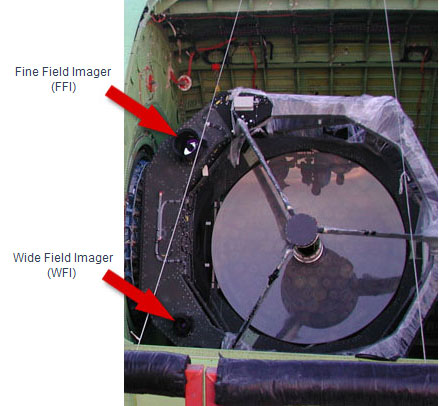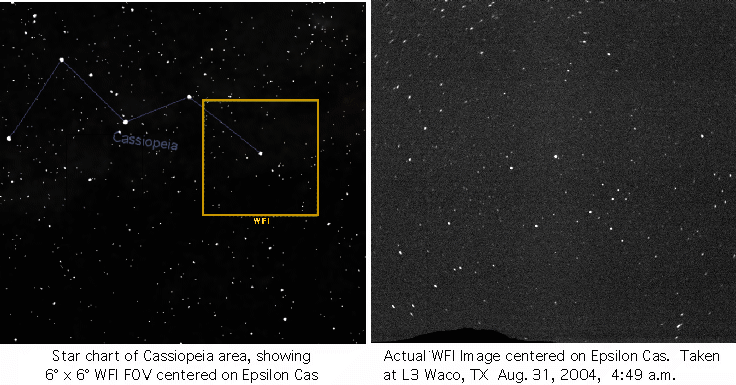SOFIA had three acquisition/guider/tracking cameras, the Wide Field Imager (WFI), the Fine Field Imager (FFI),and the Focal Plane Imager Plus (FPI+), which were designed to determine where the telescope was pointed on the sky and provide telescope pointing corrections via optical tracking on guide stars. The WFI and FFI were mounted on the telescope head ring and can be seen in the photograph below. The FPI+ imaged the telescope focal plane via a dichroic and a second tertiary mirror. All three cameras operated at optical wavelengths. The properties of the imagers are given in the table below.
| Parameter | FPI+ | FFI | WFI | Notes |
|---|---|---|---|---|
| Optics description | main 2.5m TA (Cassegrain) + 8x reduction | Schmidt-Cass + field expander | F/2 Petzval lens | FPI+ has ±60 cm focus range, reticle, reimaging optics |
| aperture diameter | 2500 mm | 254 mm | 68 mm | |
| FOV | 9’ diam. | 67’ x 67’ | 6.0° x 6.0° | |
| image scale (arc—(arc-sec/pixel) | 0.51 ”/pxl | 4.1 ”/pxl | 21 ”/pxl | FPI+ scale varies 10% over focus range |
|
star image size
(80% Enc Energy) |
6 ” | 13 ” | ~1.2 ’ | FPI+ seeing-limited; FFI, WFI optics limited |
|
R-band sensitivity
(S/N = 10 in 1 s) |
>16 | 11 | 9 | |
|
centroid precision
(S/N = 10) |
~0.05 ” | ~1 ” | ~8 ” | |
| Filters available |
|
|
|
ND (FFI/WFI) T: 8% - 75%
ND (FPI+) T: 0.001% - 5% "red" = Schott RG1000 ( l > 900 nm) |
The FFI and WFI used the same model Proscan "High Speed Slow-Scan" camera, containing a Thomson 7888A frame transfer CCD. During the Focal Plane Imager Upgrade in early 2013, the FPI+ camera was replaced with a Andor iXon DU-888 camera with an E2V CCD201-20 EMCCD. With this upgrade, the FPI+ had a higher sensitivity, lower noise and faster readout speeds. An upgrade of the front-ring cameras FFI and WFI was under development. The basic (nominal) properties of the old and upgraded CCD are given in the table below.
| Parameter | Value or range | Notes | |
|---|---|---|---|
| Imager/CCD | FFI/WFI Thomson 7888A | FPI+ E2V CCD201-20 | |
| Array dimensions | 1024 x 1024 image area | 1024 x 1024 | frame transfer readout |
| Pixel size | 14 microns | 13 microns | |
| Binning options | 1x1, 2x2, 4x4 | 1x1, 2x2, 4x4 | 4x4 done off chip for FFI/WFI |
| Integration time | 10 - 10,000 ms | 1 - 10,000 ms | |
| Data format | 14-bit 2 MHz or 8-bit 5 MHz | 16-bit 1 MHz or 14-bit 3 MHz or 14-bit 5 MHz | |
| Maximum frame rate | 8 frames / s | 11 frames / s | 4x4 binning, 5 MHz |
| Peak Q. E. | 18% at 550 nm (front illuminated) | 94% at 560nm (back illuminated) | |
| Read noise | 60 e - = 5 DN | 6 e- at 1 MHz = 9 DN 36 e- at 5 MHz = 4 DN | |
|
Dark current rate
(-30 C) |
50 e -/pixel/s | 0.06 e-/pixel/s | New FPI+ is thermo-electrically cooled, FFI and WFI stratospheric conditions |
| Gain | 12 e - / DN (14 bit, 2 MHz) ~600 e- / DN (8 bit, 5 MHz) | 0.7 e- / DN (16 bit, 1 MHz) 1.9 e- / DN (14 bit, 3 MHz) 8.9 e- / DN (14 bit, 5 MHz) | |
| Saturation | 170,000 -200,000 e - | 80,000 e- | |
The imagers acquired star field frames and on-board control software correlated the star positions with star catalogues to determine the attitude of the telescope with respect to the sky. The guider camera images could also be captured during flight and saved as FITS files; they are archived along with the science instrument data. The two image pairs shown here provide a comparison between images acquired with the WFI during tests in the summer of 2004 and star charts for the associated fields.
For telescope diagnostic purposes and for science mission support it was possible to operate FPI+ from a dedicated laptop. When operated in this mode an additional 14-bit, 10 MHz readout rate was available as well as the readout of sub-frames which could increase the maximum frame rate to 400 frames per second (for science observations specifications, see the Observer's Handbook).


